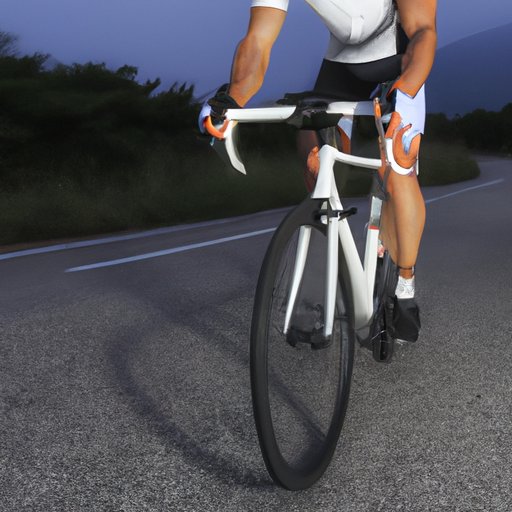Introduction
Cycling is a popular form of physical activity that has many health benefits. It is defined as the act of riding a bicycle or other two-wheeled vehicle, either for recreation or transportation. As with any exercise, cycling requires the use of certain muscles to power the movement. In this article, we will explore what muscles are worked when cycling and provide an in-depth guide for riders.
An Overview of Muscles Used in Cycling
The major muscles used in cycling include the quadriceps, hamstrings, glutes, core, and upper body muscles. These muscles work together to propel the bike forward, allowing the rider to maintain speed and power. The muscles must be used in a coordinated way to ensure efficient and effective movement.
When cycling, the primary muscles used are the quadriceps, located at the front of the thigh. The quadriceps are responsible for extending the knee, which is essential for pushing the pedals down during each stroke. The hamstrings, located at the back of the thigh, are also important for propelling the bike forward. They are responsible for flexing the knee joint and providing stability and balance while pedaling.
The glutes, or butt muscles, are also heavily involved in cycling. They provide power and stability to the legs and help keep the hips in a neutral position. The core muscles are also important for proper alignment and posture on the bike. Finally, the upper body muscles are used to help maintain control and stability while steering and maneuvering.
How to Target Specific Muscles When Cycling
In order to build strength and improve performance, it is important to target specific muscles when cycling. There are several strategies that can be used to isolate and strengthen individual muscles. For example, using a higher gear can target the quadriceps, while using a lower gear can target the hamstrings. Additionally, varying the terrain can help to target specific muscles. Hills, for example, require more power from the quadriceps, while flats require more power from the hamstrings.
There are also exercises that can be done off the bike to target specific muscles. For example, squats and lunges can be used to target the quadriceps, while deadlifts and Romanian deadlifts can be used to target the hamstrings. Core exercises such as planks and crunches can also be used to strengthen the core muscles. Finally, exercises such as push-ups and pull-ups can help to strengthen the upper body muscles.

A Comprehensive Guide to the Muscles Used in Cycling
Now that we have discussed the major muscles used in cycling and how to target them, let’s take a closer look at each muscle group. Here is a comprehensive guide to the muscles used in cycling:
Quadriceps
The quadriceps are the primary muscles used in cycling. They are responsible for extending the knee and pushing the pedals down during each stroke. Strengthening the quadriceps can help improve power and speed while cycling. Exercises such as squats and lunges can be used to target the quadriceps.
Hamstring
The hamstrings are located at the back of the thigh and are responsible for flexing the knee joint. They also provide stability and balance while pedaling. Strengthening the hamstrings can help improve power and speed while cycling. Exercises such as deadlifts and Romanian deadlifts can be used to target the hamstrings.
Glutes
The glutes are located in the buttocks and are responsible for providing power and stability to the legs. Strengthening the glutes can help improve power and speed while cycling. Exercises such as hip thrusts and step-ups can be used to target the glutes.
Core
The core muscles are located in the abdomen and are responsible for providing support and stability while cycling. Strengthening the core muscles can help improve posture and reduce fatigue while cycling. Exercises such as planks and crunches can be used to target the core muscles.
Upper Body
The upper body muscles are used to help maintain control and stability while steering and maneuvering. Strengthening the upper body muscles can help improve power and speed while cycling. Exercises such as push-ups and pull-ups can be used to target the upper body muscles.

The Benefits of Cycling for Muscle Strength and Endurance
Cycling is an excellent form of exercise for building muscle strength and endurance. It is low impact, so it is gentle on the joints and can be done by people of all ages and fitness levels. Additionally, cycling has many other health benefits, including:
- Improved cardiovascular fitness
- Improved muscle tone
- Increased range of motion
By incorporating regular cycling into your routine, you can reap these benefits and improve your overall health and well-being.

A Comparison of the Muscles Used in Different Types of Cycling
The muscles used in cycling vary depending on the type of cycling you are doing. Road cycling requires more power from the quadriceps and hamstrings, while mountain biking requires more power from the glutes and core muscles. Track cycling requires more power from the upper body muscles. By understanding the differences between these types of cycling, you can tailor your training to maximize the benefits.
Conclusion
In this article, we explored the muscles used in cycling. We discussed an overview of the major muscles used in cycling, how to target specific muscles when cycling, a comprehensive guide to the muscles used in cycling, the benefits of cycling for muscle strength and endurance, and a comparison of the muscles used in different types of cycling. By understanding the muscles used in cycling and how to target them, you can optimize your performance and reap the many health benefits of cycling.
Further research could focus on the effects of different types of cycling on muscle development and performance. Additionally, further research could explore the relationship between strength training and cycling performance.


